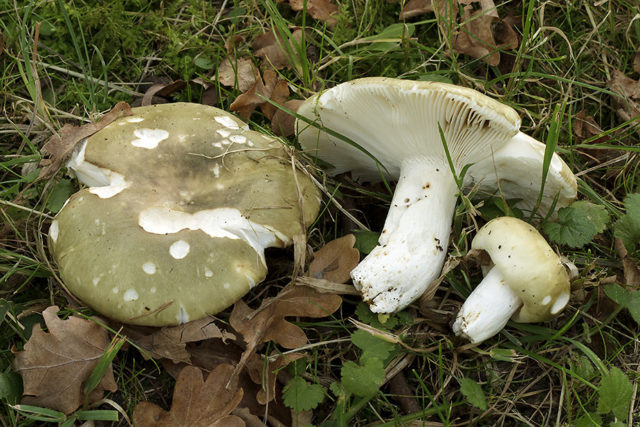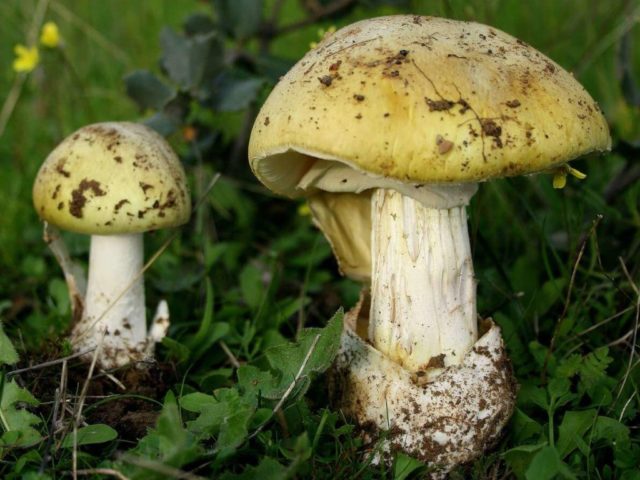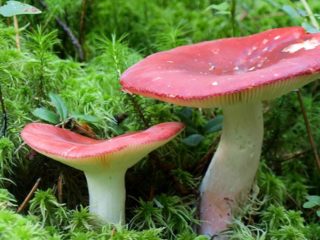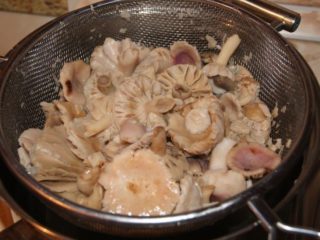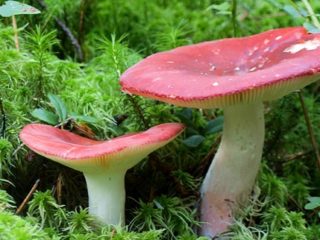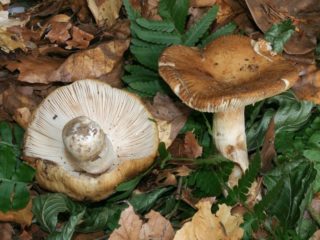Content
Russula fork (Russula heterophylla) is an edible mushroom from the Russula family, common to European forests. The period of active growth is from the end of July to September.
Where do forked russula grow?
Russula fork (variegated) can be found in broad-leaved and mixed forests, especially with a predominance of birch, aspen and oak. The mushroom grows both singly and in groups, sometimes forming entire glades. Most often, forked russula can be found in young plantings.
What do forked russulas look like?
Russula fork belongs to the lamellar mushrooms. At a young age, the cap has a hemispherical shape, but as it grows, it opens up and forms a wide funnel. Depending on the growing conditions, the diameter of the cap can vary from 5 to 12 cm. The skin is thin, dry, slippery in rainy weather, finely ribbed along the edge, easily removed up to ¼ of the diameter of the cap. The color of the film cover can be:
- gray-green;
- bluish-green;
- yellowish-green;
- brownish;
- yellow (rarely).
The central part of the funnel is colored more intensely - olive, and in some cases, dark brown; there may be a velvety feel in the middle. The plates are located almost close to each other; closer to the stem they intertwine and grow towards it in a descending manner. The color of the plates is milky, cream or yellowish-greenish, sometimes they have brown-brown fragments.
The stem of the forked russula is strong, in the shape of a cylinder or less often a cone, solid at the base and in some cases hollow closer to the cap. Voids in the stalk structure appear as the mushroom grows. Height – on average 6 cm. The surface of the leg is smooth, without gloss, color – almost white. With high humidity, yellowish spots may appear, and the legs of old mushrooms become wrinkled.
The pulp of the forked russula has a dense structure, the plates are brittle. When cutting or breaking, no milky juice is released. The pulp is white, turning yellowish when exposed to air.
Is it possible to eat forked russula?
Russula heterophylla is an edible mushroom. Some types of russula can be consumed fresh, without pre-processing. This is safe if the mushroom picker is experienced and can accurately distinguish one variety from another. Due to their prevalence, russulas of various plates, along with food, green and yellow ones, are a familiar product on the Russian table. There are a great many recipes for preparing these mushrooms, and most of them are simple and quick, even an inexperienced housewife can do it.
Taste qualities
The taste of forked russula is tender and sweetish, there is no pronounced mushroom smell. There is also no bitter taste.
Benefits and harms
Russula is a low-calorie product rich in vitamins and minerals.The pulp of the mushroom consists of 90% water; 100 g contains only 19 kcal. A serving of 150 g is enough to satisfy the body's daily need for protein. The pulp contains:
- vitamins: PP, B1, B2, C, E;
- minerals: K, Ca, Mg, Na, P and Fe.
Mushrooms contain a large amount of protein. This is a favorite product of vegetarians, who thus compensate for the protein deficiency that occurs due to refusal of food of animal origin.
Consumption of russula in acceptable quantities has a positive effect on the human body:
- immunity is strengthened;
- the risk of cancer is reduced;
- metabolic processes are normalized;
- blood vessels are cleansed;
- harmful substances are adsorbed and quickly eliminated;
- the condition of nails, teeth, hair, skin improves.
The presence of russula in the diet prevents emotional disorders and mental exhaustion. Mushrooms remove excess water and promote weight loss.
However, like many other products, forked russula has its own contraindications. They are not recommended for consumption in the following cases:
- pregnancy and lactation;
- inflammatory processes in the digestive system;
- chronic diseases of the gastrointestinal tract;
- heart diseases;
- liver dysfunction;
- individual intolerance.
Collection rules
In adulthood, with the cap open, the forked russula is very fragile. A wide basket or bucket is suitable for collecting them; in a plastic bag or backpack they will quickly turn into dust. Increased fragility is due to the presence of special vesicular cells in the fruiting body, called spherocysts.
Young, not overgrown specimens are suitable for food.Old mushrooms accumulate harmful substances and can be dangerous to humans. Collecting forked russula and other species near industrial enterprises and highways is fraught with poisoning.
The mushrooms are cut off together with the stem, checked for worms, then the cap is cut off and carefully placed in a basket with the plates facing down. In this position, they will remain clean, and spruce needles and other plant debris will not get stuck in them. This will make the reassembly job much easier. After harvesting, fork russulas retain their beneficial properties for 1-2 days, so they need to be processed and cooked immediately.
When going to the forest to pick mushrooms, you must take with you:
- a bottle of water and a snack (sandwiches);
- hydrogen peroxide and plaster;
- telephone (for calling 112);
- GPS navigator (if available);
- basket and knife.
False doubles of Russula fork
Forked russula can be confused with a deadly mushroom - toadstool (Amanita phalloides). The poisonous twin can be distinguished by a characteristic tuberous thickening at the base of the stalk. Young, pale toadstools have a film (volva) covering the fruiting body; in mature ones, the “skirt” on the stalk is clearly visible.
Symptoms of poisoning with toadstool do not appear immediately, but 6-72 hours after eating it. A person experiences the following symptoms:
- vomit;
- diarrhea;
- intestinal colic;
- muscle pain;
- decreased heart rate and blood pressure;
- liver enlargement.
Most poisonings are fatal due to toxic hepatitis and acute heart failure.
Application of forked russula
Forked russulas are widely used in cooking:
- fry;
- boil;
- salt;
- marinate;
- ferment;
- frozen.
Unlike other types of mushrooms, russula can be pickled a day in advance.It is enough to clear them of forest debris, rinse them, soak them briefly, and then, adding salt, spices and garlic, place them under pressure for 12 hours.
The healing properties of Russula fork have been known since time immemorial. Healers used it to treat ailments such as:
- headache;
- boils;
- frostbite;
- corns (dry calluses);
- disruptions in the psycho-emotional sphere.
Conclusion
Russula fork may be inferior to boletus and boletus in taste, but in the skillful hands of a skilled cook it can turn into an exquisite dish. These mushrooms are a storehouse of substances beneficial to the body. Russulas are easy to find and pleasant to collect, and a trip to the forest is not only a useful activity, but also relaxation for the soul.
